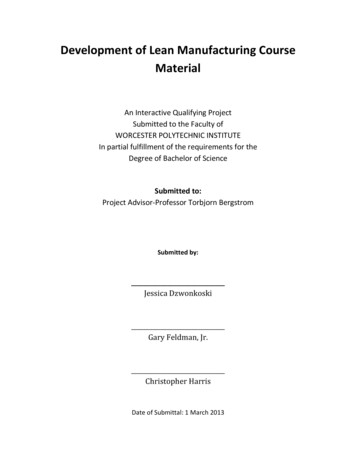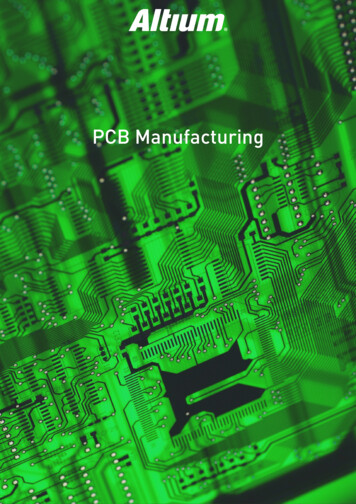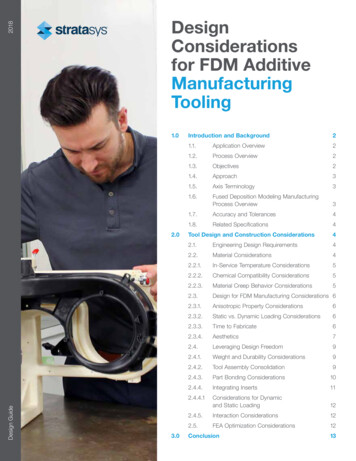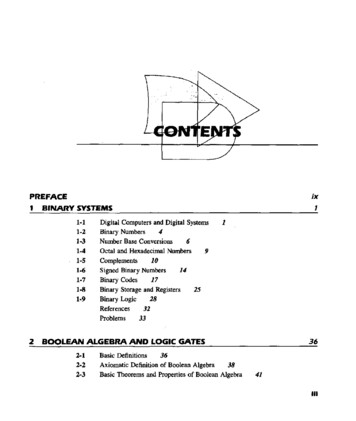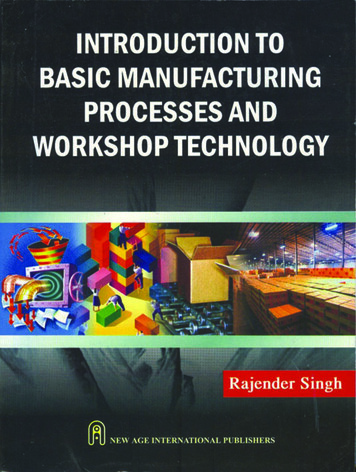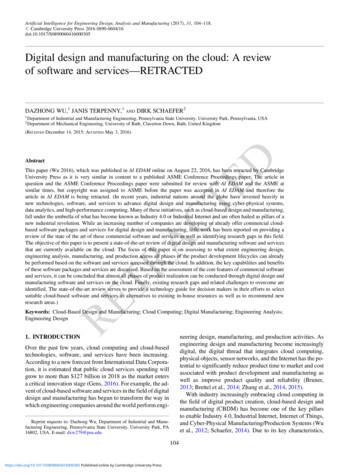
Transcription
Artificial Intelligence for Engineering Design, Analysis and Manufacturing (2017), 31, 104–118.# Cambridge University Press 2016 0890-0604/16doi:10.1017/S0890060416000305Digital design and manufacturing on the cloud: A reviewof software and services—RETRACTEDDAZHONG WU,1 JANIS TERPENNY,1 AND DIRK SCHAEFER212Department of Industrial and Manufacturing Engineering, Pennsylvania State University, University Park, Pennsylvania, USADepartment of Mechanical Engineering, University of Bath, Claverton Down, Bath, United KingdomED(RECEIVED December 14, 2015; ACCEPTED May 3, 2016)AbstractRETRACTThis paper (Wu 2016), which was published in AI EDAM online on August 22, 2016, has been retracted by CambridgeUniversity Press as it is very similar in content to a published ASME Conference Proceedings paper. The article inquestion and the ASME Conference Proceedings paper were submitted for review with AI EDAM and the ASME atsimilar times, but copyright was assigned to ASME before the paper was accepted in AI EDAM and therefore thearticle in AI EDAM is being retracted. (In recent years, industrial nations around the globe have invested heavily innew technologies, software, and services to advance digital design and manufacturing using cyber-physical systems,data analytics, and high-performance computing. Many of these initiatives, such as cloud-based design and manufacturing,fall under the umbrella of what has become known as Industry 4.0 or Industrial Internet and are often hailed as pillars of anew industrial revolution. While an increasing number of companies are developing or already offer commercial cloudbased software packages and services for digital design and manufacturing, little work has been reported on providing areview of the state of the art of these commercial software and services as well as identifying research gaps in this field.The objective of this paper is to present a state-of-the-art review of digital design and manufacturing software and servicesthat are currently available on the cloud. The focus of this paper is on assessing to what extent engineering design,engineering analysis, manufacturing, and production across all phases of the product development lifecycles can alreadybe performed based on the software and services accessed through the cloud. In addition, the key capabilities and benefitsof these software packages and services are discussed. Based on the assessment of the core features of commercial softwareand services, it can be concluded that almost all phases of product realization can be conducted through digital design andmanufacturing software and services on the cloud. Finally, existing research gaps and related challenges to overcome areidentified. The state-of-the-art review serves to provide a technology guide for decision makers in their efforts to selectsuitable cloud-based software and services as alternatives to existing in-house resources as well as to recommend newresearch areas.)Keywords: Cloud-Based Design and Manufacturing; Cloud Computing; Digital Manufacturing; Engineering Analysis;Engineering Designneering design, manufacturing, and production activities. Asengineering design and manufacturing become increasinglydigital, the digital thread that integrates cloud computing,physical objects, sensor networks, and the Internet has the potential to significantly reduce product time to market and costassociated with product development and manufacturing aswell as improve product quality and reliability (Bruner,2013; Brettel et al., 2014; Zhang et al., 2014, 2015).With industry increasingly embracing cloud computing inthe field of digital product creation, cloud-based design andmanufacturing (CBDM) has become one of the key pillarsto enable Industry 4.0, Industrial Internet, Internet of Things,and Cyber-Physical Manufacturing/Production Systems (Wuet al., 2012; Schaefer, 2014). Due to its key characteristics,1. INTRODUCTIONOver the past few years, cloud computing and cloud-basedtechnologies, software, and services have been increasing.According to a new forecast from International Data Corporation, it is estimated that public cloud services spending willgrow to more than 127 billion in 2018 as the market entersa critical innovation stage (Gens, 2016). For example, the advent of cloud-based software and services in the field of digitaldesign and manufacturing has begun to transform the way inwhich engineering companies around the world perform engiReprint requests to: Dazhong Wu, Department of Industrial and Manufacturing Engineering, Pennsylvania State University, University Park, PA16802, USA. E-mail: 16000305 Published online by Cambridge University Press
Digital design and manufacturing in the cloud2. ENGINEERING DESIGN ON THE CLOUDRETRACT† Enhanced functionality: CBDM allows users to solvelarge-scale and complex design and engineering analysis problems (e.g., finite element analysis, computational fluid dynamics, optimization, visualization, andphotorealistic rendering) that typically require highperformance processors and very large memory.† Anytime, anywhere access: CBDM enables users to acquire access to any computer-aided design/computeraided engineering/computer-aided manufacturing (e.g.,ANSYS and AutoCAD) software packages and stateof-the-art HPC computing infrastructures (e.g., centralprocessing unit cores, graphics processing units, memory,and high-speed interconnects) via a web portal and/orapplication program interfaces anytime, anywhere.† Cost efficiency: CBDM fundamentally changes the waymanufacturers implement digital design and manufacturing from a business perspective by offering variouspricing models such as pay-per-use, subscription, andauction-based pricing plans. For example, AutoCADand ANSYS implemented the subscription pricingmodel by charging a fixed price in advance for a predefined period of time (e.g., per month or per year).† Secure and high volume data storage: CBDM providesmanufacturers with reliable, secure, scalable, and economical storage of massive static and dynamic data.The advantage of cloud storage is that it delivers highperformance, low-latency communication for input/output intensive workloads such as high-speed datacollection and processing.† High flexibility: CBDM enables users to scale up anddown computing capacity on demand and transformdedicated HPC clusters into flexible HPC clouds thatcan be shared and adapted for rapidly changing customerrequirements through private, hybrid, and public clouds.† High throughput: CBDM can significantly increase theutilization of computing resources as opposed to dedicated on premise services by allowing globally dispersedengineering teams to perform complex engineering analysis and simulations concurrently and collaboratively.The objective of this paper is to provide an overview of thecloud-based design and manufacturing-related software andservices that have already become readily available andthus to serve as a technology guide for decision makers intheir efforts to select suitable cloud-based resources as alternatives to existing in-house resources. Key gaps in capabilities and research needs are also identified. Toward thisend, a repository of existing cloud-based software and services as well as service providers that support the variousphases of the product creation process has been compiledand is presented. Specifically, we analyze the key capabilitiesand benefits of existing cloud-based software packages andservices available in the market.The remainder of the paper is organized as follows: Sections 2, 3, 4, and 5 present cloud-based software and servicesfor engineering design, engineering analysis, manufacturing,and production, respectively. Section 6 provides directionsfor future research in the field of cloud-based design, engineering analysis, manufacturing, and production. Section 7provides conclusions and the contributions of this research.EDCBDM has the potential to serve as a backbone of the industrial digital thread because it allows for a variety of modeling,simulation, and manufacturing software packages and services to be connected on demand. CBDM enables scalable,ubiquitous, seamless, and instant access to remote advanceddigital design and manufacturing resources including, amongothers, finite element analysis and computational fluid dynamics (CFD) software packages as well as high-performancecomputing (HPC) resources for simulation (Wu et al., 2015).In a broader sense, CBDM can be used to build entire highlycustomized and agile information and communication technology infrastructures that integrate application software,digital models, sensors, machines, and big data analyticsapplications for product creation.More specifically, the unique capabilities and benefits ofCBDM are as follows (Wu et al., 2013):105https://doi.org/10.1017/S0890060416000305 Published online by Cambridge University PressTable 1 lists the primary phases of a typical engineering designprocesses, including product planning, conceptual design,embodiment design, and detail design. The first phase,product planning, refers to a process of identifying marketor customer requirements that define the product conceptand associated product features. The essence of product planning is to study the market, identify the preferences and requirements of customers and users, and define associatedproduct life cycles. Traditional tools for product planninginclude customer surveys and/or market research questionnaires, which could be very time consuming and inaccurate.In the context of contemporary 21st-century product development, Salesforce Market Cloud is a provider of cloud-baseddigital marketing automation and analytics software and services. Salesforce Market Cloud delivers market analyticsusing a dynamic visualization engine and massively parallelcomputing infrastructure. However, Salesforce Market Cloudcannot yet automatically collate customer reviews from online review sites and social media platforms such as Amazon,Google, Twitter, Epinions, CNET, Sazze, Retrevo, or Social.com. In the second design phase, conceptual design, productideas are generated, evaluated, and selected. Traditional toolsfor conceptual design include brainstorming, reasoning, modeling, representation, the use of morphological matrices,Pugh’s method, and other aids of decision making. Althoughdecisions made at the conceptual design stage have significant influence on costs, performance, and reliability of aproduct, to date only few cloud-based tools for conceptual design support exist due to a lack of mechanisms and techniquesfor automating product ideation. The third and fourth phasesof traditional systematic engineering design are embodimentdesign and detail design in which system configuration, layouts, and geometries are generated. The natural choice of tool
106D. Wu et al.Table 1. Cloud-based tools and services supporting the product creation processCloud-BasedToolsPartly or KSYesFullyComputer-aided designYesFullyStructure analysisFinite element analysisYesFullySiemens PLMSoftwareAutodesk, DassaultSystèmesANSYSThermal analysisEngineering erical controlProcess planningProductionmanagementDistribution andlogisticsFinite element analysisComputational fluid ully3-D SystemsComputer-aided manufacturingYesFullyAutodeskSubphaseTraditional Tools or SoftwareEngineering designProduct planningConceptual designEmbodiment designSurvey, questionnaireBrainstorming, reasoning, modelingrepresentation, morphological matrixComputer-aided designDetail er-aided process planningBill of materials, planning andscheduling, process monitoringDiscrete event iderAutodeskPlex SystemsNAACTProductionEDMain PhaseRETRfor both embodiment and detail design has been and still isthe utilization of computer-aided design (CAD) systems.Due to the high degree of automation and digitalizationinherent to the embodiment and detail design phases, variouscloud-based CAD tools and services for low-, medium-, andhigh-end customers have been developed. Table 1 representsa snapshot of the current state. It is by no means meant to becomplete or conclusive. Rather, we acknowledge that newCBDM solutions and services are being developed as weconduct this survey. More detailed discussions of the existingcloud-based tools, software, and services as well as their keycapabilities and benefits follow in subsequent sections.Table 2 lists the leading CAD services on the cloud, serviceproviders, deployment models, key capabilities and features,and cloud infrastructure providers.Autodesk 360 is a cloud computing platform that providescloud-based design services that enable engineers to conductengineering design and share digital documents anytime,anywhere through cloud computing platforms. The key capabilities and benefits of AutoCAD 360 include† cloud-based data management using cloud storage services such as Dropbox, Box, Egnyte, and Buzzsaw and† remote access to two-dimensional (2-D) drawings in theDWF and DWG formats on multiple devices using a webbrowser, smart phone, tablet, and desktop computer.As shown in Figure 1, the free version of AutoCAD 360enables users to view drawings; draw simple lines, rectangles,and circles; save drawings with AutoCAD 360 or third-partycloud storage; and move, scale, rotate, erase, and copy objectshttps://doi.org/10.1017/S0890060416000305 Published online by Cambridge University Pressvia a web browser or a mobile device. The Pro version of AutoCAD 360 offers more advanced functionality, includingcreating new drawings, drawing arcs and arrows, and advanced layer management.The other cloud-based three-dimensional (3-D) CAD tooloffered by Autodesk is Fusion 360. Fusion 360 can run onboth Mac and Windows operating systems. The key capabilities and benefits of Autodesk Fusion 360 include††††cloud-based rendering,cloud-based distributed design,cloud-based mobile viewing, andcloud-based part libraries.For example, as shown in Figure 2, Fusion 360 enablesusers to create smooth and precise surfaces with T-Splinestechnology or with sketch curves, patches, and extrusionsvia a web browser. Designers can take advantage of virtuallyunlimited computing power to create photorealistic and highresolution images on the cloud.PTC PLM Cloud offers cloud-based Creo and Windchillthat can accelerate product development and help designteams minimize information technology complexity andcost with a secure cloud infrastructure. PTC PLM Cloud’sfunctionality is equivalent to Windchill PDMLink and ProjectLink. Similar to AutoCAD 360 and Fusion 360, the keyfeatures of Creo and Windchill on the cloud include† cloud-based product data management,† cloud-based product analytics, and† cloud data storage.
Digital design and manufacturing in the cloud107Table 2. CAD services on the cloudHeadquartersAutodeskCalifornia, USAProductAutoCAD 360Fusion 360PTCMassachusetts, USATinkercadCreoDeploymentFeaturesCloud or onpremiseCloud or onpremise2-D drafting, data storage, web and mobileappFreeform modeling, solid modeling,parametric modeling, mesh modeling,rendering, part libraries2-D and 3-D modeling, data storage2-D and 3-D modeling, parametricmodeling, concept design, detail designProduct data management, product lifecycle management, product analytics,collaborationMulti-CAD integration, social networking,BOM management, requirementsmanagement, product cost management,mobile appProduct design, industrial design andstyling, drafting and documentation,electromechanical design, mechatronicsdesign2-D drafting, 3-D modeling, advancedsheet metal design, assembly creationand management, photorealisticrendering, mobile appCAD animation, revision control, part andassembly modeling, tolerance analysis,CAD library, interference check2-D drafting, 3-D modeling, paralleldesign, interference check, real-timecollaborationPart modeling, assembly modeling,drawings, collaboration, datamanagement, mobile app2-D drafting, 3-D modeling, photorealisticrenderingCloudCloud or onpremiseWindchillDassaultSystèmesTexas, USAVélizy-Villacoublay,FranceTeamcenterCloud or onpremiseNXCloud or onpremiseSolid EdgeCloud or onpremiseSOLIDWORKSCloud or onpremiseCATIACloud or onpremiseMassachusetts, USAOnshapeStratasysMassachusetts, USAGrabCADCloud or vate Cloud, AutodeskPrivate Cloud, Autodesk, 32physical cores, 72 threads on asingle machinePrivate Cloud, AutodeskPublic Cloud, Amazon WebServicesPrivate Cloud, Windchill360.com,Public Cloud, Amazon WebServicesPublic Cloud, Amazon WebServices, Microsoft AzurePrivate Cloud, NVIDIA GRIDtechnology for Virtual desktopEDVendorPrivate Cloud, NVIDIA GRIDtechnology for Virtual desktopPrivate Cloud, NVIDIA GRIDtechnology for Virtual desktopPublic Cloud, Amazon WebServicesPrivate CloudPublic Cloud, Amazon S3RENote: See Distler (2015), IntelliCAD (2015), Onshape (2015), Siemens (2015b), SOLIDWORKS (2015), and Windchill (2015).Fig. 1. AutoCAD 360 interface (Dobrzynski, 2013).https://doi.org/10.1017/S0890060416000305 Published online by Cambridge University Press
D. Wu et al.ED108TRACTFig. 2. AutoCAD Fusion 360 interface (Fusion360, 2015).REFig. 3. View and edit three-dimensional model using Willchill on the cloud (Willchill, 2015). Copyright 2015 by PTC, Inc. Reprinted withpermission.Both PTC Creo and Windchill offer cloud and on-premiseversions. PTC offers three PTC PLM Cloud packages, including standard, premium, and enterprise. The standard packageallows for multitenant and preconfigured Windchill and Creoinstances that support up to 15 CAD seats. The premiumpackage allows for dedicated virtual PTC Windchill andCreo instances that support customer-specific system configuration with more than 15 CAD seats. Similar to the premiumpackage, the enterprise package allows for dedicated virtualPTC Windchill and Creo instances that support integrationsto corporate systems in addition to customer-specific systemconfiguration. PTC Creo is currently only available via Amazon Web Services (AWS) in North America. Figure 3 showsthe interface of Willchill on the cloud. PTC Windchill isavailable through AWS and Microsoft Azure.Teamcenter developed by Siemens PLM Software is delivered through the Infrastructure as a Service (IaaS) platform.https://doi.org/10.1017/S0890060416000305 Published online by Cambridge University PressTeamcenter on the cloud enables users to move some or all oftheir computing infrastructure to a third-party cloud service provider without heavy upfront investments on information andcommunication technology infrastructure and resources. Currently, Siemens supports Teamcenter on three of the leadingcloud service providers: Microsoft Azure, IBM SmartCloud,and AWS. Teamcenter on the cloud provides fast and flexibledeployment of virtual Teamcenter environments with the abilityto dynamically scale infrastructure up and down based on customers’ needs. In addition to Teamcenter, Siemens PLM offersthe NX 3-D design software in a private cloud environment bypartnering with NVIDIA, as shown in Figure 4. Specifically,with NVIDIA GRID vGPU, Siemens NX enables users to conduct 3-D graphics-intensive applications such as 3-D renderingvia virtual desktop infrastructure.Dassault Systèmes has developed a portfolio of cloud-basedsolutions such as cloud-based SOLIDWORKS, CATIA, and
Digital design and manufacturing in the cloud† WebGL rendering, and† data management.Specifically, Onshape claims that the architecture of theOnshape system is significantly different from traditionalCAD systems in which users work on files. In the Onshapesystem, users do not work on files but on compound documents, which are stored on the cloud as database entities.These database entities consist of a part or assembly. In addition, users do not need to be concerned about version controlanymore. Another unique characteristic of Onshape is that itenables multiple users to create new features on existing 3-Dmodels or modify existing features. A more important featureis that Onshape is developed using WebGL, which is a JavaScript application program interface for rendering interactive3-D graphics via a web browser. WebGL is widely supportedby various web browsers such as Mozilla Firefox, GoogleChrome, Safari, and Internet Explorer.GrabCAD, acquired by Stratasys in 2014, was founded in2009 with the goal of building an online community for mechanical engineers to manage and share CAD models. Userscan upload and download 3-D files from a free, open-sourceCAD library created by GrabCAD. The GrabCAD libraryhas more than 910,000 open-source CAD models. GrabCADreleased Workbench, which is a free cloud-based collaborationtool that enables multiple users to view and edit the same CADmodels simultaneously. Workbench is hosted on Amazon Simple Storage Service. Particularly, Workbench is completelyfree. There are no limits on data storage, number of projects,and number of users. In addition, GrabCAD provides 3-Dmodel interrogation, inspection, and visualization within theWorkbench by partnering with Siemens’ Parasolid software.Figure 9 shows the interface of GrabCAD on the cloud.RETRACTSIMULIA via the 3DEXPERIENCE platform. Specifically,the features of SOLIDWORKS on the cloud include CADanimation, revision control, part and assembly modeling,tolerance analysis, CAD library, and interference check. In particular, SOLIDWORKS Conceptual Designer (SWCD) is atpresent perhaps the only cloud-based concept design tool forthe rapid creation, manipulation, and modification of designsfor mechanical components. Figure 5 depicts the interface ofSWCD on the cloud. Specifically, sketch motion enables designers to evaluate design concepts in the early design phaseusing trace paths and area sweeps. Deformable 3-D geometryenables designers to conduct instant performance verificationfor 3-D mechanical components. Mechanism synthesis enables designers to define a dimensioned layout of a mechanism before embodiment design and detail design. Conceptmanagement allows designers to easily compare a numberof design concepts. Similar to SOLIDWORKS Mechanicalconcept, SOLIDWORKS Industrial Design (SWID), as shownin Figure 6, is another cloud-based tool available on the3DEXPERIENCE platform. SWID allows industrial designers to quickly create shapes and forms that will help promoteproduct satisfaction, brand identify, and loyalty using nativeand imported geometry. SWID provides a virtual sketchpadas well as rendering, surface modeling, and parametric modeling capabilities. In addition to SWCD and SWID, CATIA isalso available on the cloud, as shown in Figure 7. The key feature of CATIA on the 3DEXPERIENCE platform is real-timevisualization and photorealistic rendering.Onshape is a cloud-based CAD system developed for collaborative design. As shown in Figure 8, Onshape can be runin a web browser on any mobile devices on the Windows,Mac, and Linux operating systems. The key capabilities andbenefits of Onshape includeFig. 5. Cloud-based SOLIDWORKS mechanical conceptual (SOLIDWORKS, 2015a). Copyright 2015 by Dassault Systèmes. Reprinted withpermission.EDFig. 4. Cloud-based Siemens NX software using NVIDIA GRID’s virtualdesktop (Siemens, 2015b). Copyright 2015 by Siemens Product LifecycleManagement Software, Inc. Reprinted with permission.109† the ability to modify a model simultaneously by severalusers,† version control,https://doi.org/10.1017/S0890060416000305 Published online by Cambridge University Press3. ENGINEERING ANALYSIS ON THE CLOUDComputer-aided engineering (CAE) refers to the use of application software to aid engineering analysis tasks, including
110D. Wu et al.TRACTEDFig. 6. Cloud-based SOLIDWORKS industrial designer interface (SOLIDWORKS, 2015b). Copyright 2015 by Dassault Systèmes.Reprinted with permission.REFig. 7. CATIA on the SIMULIA cloud-based solutions 3DEXPERIENCE platform (CATIA, 2015).Fig. 8. Onshape on the cloud (Onshape, 2015a).structural analysis, thermal and fluid flow analysis, multibodydynamics, kinematics, process simulations, and optimization.Specifically, CAE application packages support a wide rangeof engineering disciplines or phenomena, includinghttps://doi.org/10.1017/S0890060416000305 Published online by Cambridge University Press††††finite element analysis,mechanical event simulation,multibody dynamics,manufacturing process simulation,
Digital design and manufacturing in the cloud111Table 3. Computer-aided engineering services on the cloudVendorHeadquartersProductDeploymentCloud or onpremisePennsylvania,USACD-adapcoNew York, USAANSYS Fluent,Mechanical, CFX,Electronics,ElectromagneticSTAR-CCM MSC SoftwareCalifornia, ranceCalifornia, USACraft TechCloud or onpremiseTRCloud or onpremiseSIMULIACloud or onpremiseLS-DYNACloud or onpremiseRELSTCOpen SourceFeaturesPennsylvania,USACrunch CFDCloud or onpremiseNAOpenFOAMCloudInfrastructureElectronics, fluid dynamics, structuralanalysis, multiphysicsANSYS EnterpriseCloud, AmazonWeb ServicesComputational fluid dynamics, heattransfer, chemical reaction, combustion,solid transport and acousticsLinear and nonlinear finite elementanalysis, acoustics, fluid-structureinteraction, multiphysics, optimization,fatigue and durability, multibodydynamics, and control systemssimulationFinite element analysis, computational fluiddynamics, multiphysicsPublic CloudACTANSYSEDFig. 9. GrabCAD on the cloud (GrabCAD, 2015).Finite element analysis, thermal analysis,fluid analysis, failure analysis, crackpropagation, multiphysics coupling,rigid body dynamicsMultiphysics, fluid analysis, thermalanalysis, acoustic propagation, reactingflowComputational fluid dynamics, heattransfer, multiphase flow, moleculardynamics, solid mechanics,electromagneticsIBM Cloud, NimbixCloudPublic Cloud,Amazon WebServicesPublic CloudPublic CloudPublic CloudNote: See ANSYS (2015), CD-adapco (2015), CraftTech (2015), Cart3D (2015), Dassault Systèmes (2015), IBM (2015), LSTC (2015), and OpenFOAM (2015).††††process optimization,computational fluid dynamics,product optimization, andmultiphysics solutions.Table 3 lists the leading CAE services on the cloud, theirservice providers, deployment models, key capabilities andhttps://doi.org/10.1017/S0890060416000305 Published online by Cambridge University Pressfeatures, and cloud infrastructure providers. More detaileddiscussions of the CAE services on the cloud follow in subsequent sections.The ANSYS Enterprise Cloud is an enterprise-level engineering simulation platform on the cloud, hosted by the ANSYS dedicated corporate account on the AWS platform. Currently, ANSYS Mechanical, Electronics, Fluent, CFX, CFD,
112D. Wu et al.ACTEDFig. 10. ANSYS on the Nimbix Cloud (Nimbix, 2016).Fig. 11. LS-DYNA on the Nimbix Cloud (Nimbix, 2016).RETRand LS-DYNA have been implemented on both public andprivate clouds. Figure 10 shows the interface of ANSYS onthe Nimbix Cloud. In addition, ANSYS partners with multiple cloud service providers, including CADFEM, CPU24/7,Fujitsu, GOMPUTE, Nimbix, and Penguin Computing, toprovide users with ubiquitous access to HPC in multitenantor single-tenant environments. For example, Nimbix deliversANSYS applications as a service in both batch and interactivemodes. Users have on-demand access to the Nimbix cloud securely from any browser, device, or network.CD-adapco provides cloud-based CFD software by partnering with multiple cloud infrastructure providers such asGompute, Nimbix, and Rescale. Specifically, CD-adapcoSTAR-CCMþ is one of the most comprehensive simulationproducts for solving problems involving flow, heat transfer,and stress. Gompute is a cloud infrastructure provider who delivers HPC resources over the Internet. Gompute providescomputing power, remote visualization, storage, and applications provided by third-party software providers such as CDadapco. MSC Nastran is a multidisciplinary structural analysisapplication that help engineers perform static, dynamic, andthermal analysis across the linear and nonlinear domains aswell as structural optimization and fatigue analysis. LS-DYNAis a general-purpose multiphysics simulation software packagedeveloped by the Livermore Software Technology Corporation.Figure 11 shows the interface of LS-DYNA on the Nimbixhttps://doi.org/10.1017/S0890060416000305 Published online by Cambridge University PressCloud. Crunch CFD is a multiphysics simulation tool for solvingcomplex flow problems. Crunch CFD can run on Amazon EC2for scalable, large-scale computing. OpenFOAM is an opensource CFD software developed by OpenCFD at ESI Group under the GNU General Public License. OpenFOAM is availableon several public clouds, including Sabalcore, Amazon EC2,Microsoft Azure, and Rescale.The key capabilities and benefits of aforementioned cloudbased engineering analysis software tools include† high-performance cloud computing infrastructure anddata visualization,† cloud-based parallel and distributed computing,† cloud-based data management and data security via encryption and disaster recovery services,† flexible pricing models, and† remote hardware accelerated graphics for pre/post operations to minimize data transfer.4. MANUFACTURING ON THE CLOUDComputer-aided manufacturing (CAM) refers to the use ofnumerical control (NC) computer software applications tocreate detailed instructions (G-code) that drive computerNC (CNC) machine tools for manufacturing parts. Manufacturers in a variety of industries depend on the capabilities of
Digital design and manufacturing in the cloud113Table 4. Manufacturing services on the frastructureData storage, tool pathgeneration, CNCprogramming,postprocessing andsim
offered by Autodesk is Fusion 360. Fusion 360 can run on both Mac and Windows operating systems. The key capabil-ities and benefits of Autodesk Fusion 360 include † cloud-based rendering, † cloud-based distributed design, † cloud-based mobile viewing, and † cloud-based part libraries. For example,


